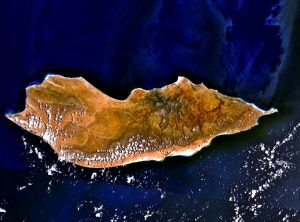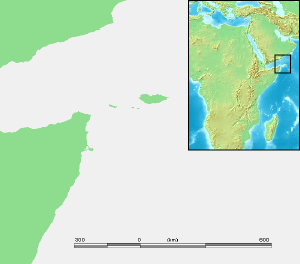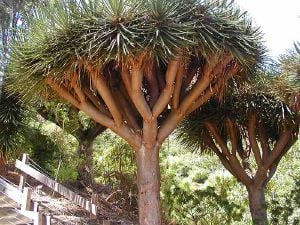Socotra
| Native name: Suquṭra سقطرى | |
 Landsatview over Socotra | |
| Geography | |
|---|---|
 | |
| Location | Indian Ocean |
| Coordinates | Coordinates: |
| Archipelago | Socotra islands |
| Total islands | 4 |
| Major islands | Socotra, Abd al Kuri, Samhah, Darsah |
| Area | 3,796 km² (1,466 sq mi) |
| Highest point | unnamed point in the Haghier Mountains (1,503 m (4,930 ft)) |
| Country | |
| Governorate | Hadhramaut Governorate (حضرموت) |
| Districts | Hidaybū (east) Qulensya Wa Abd Al Kuri (west) |
| Largest city | H̨adībū (8,545) |
| Demographics | |
| Population | 42,842 (as of 2004 census) |
| Density | 11.3 people/km2 |
| Ethnic groups | predominantly Arab; but also Afro-Arab, South Asian, Somali, and European |
Socotra or Soqotra (Arabic سقطرى ; Suquṭra) is a small archipelago of four islands and islets in the Indian Ocean off the coast of the Horn of Africa some 190 nautical miles (220 mi/350 km) south of the Arabian peninsula, belonging to the Republic of Yemen. It has long been a part of the 'Adan Governorate, but in 2004 it became attached to the Hadhramaut Governorate, which is much closer to the island than 'Adan (although the closest governorate would be Al Mahrah).
The name of the island is believed to come from Sanskrit 'dvipa sakhadara', which can be translated with 'Island of Bliss'.
Geography and climate
Socotra is one of the most isolated landforms on Earth of continental origin rather than volcanic origin. The islands of the archipelago stand on coral banks and are believed to have once been connected with the African and Arabian mainlands. Once a part of the ancient southern supercontinent of Gondwana, it is generally accepted that they detached during the Middle Pliocene (ca 6 million years ago), in the same set of rifting events that opened the Gulf of Aden to its northwest.
The archipelago consists of the main island of Socotra (3,625 km² or 1,400 sq mi), the three smaller islands of Abd al Kuri, Samhah, and Darsa, and small rock outcrops like Ka’l Fir’awn and Sābūnīyah that are uninhabitable by humans but important for birds.
The main island has three geographical terrains: the narrow coastal plains, a limestone plateau permeated with karstic caves, and the Haghier Mountains. The mountains rise to 5,000 feet (1,525 m). The island is a little over 80 miles (130 km) long east to west and typically 18-22 miles (30-35 km) north to south.
The climate is generally tropical desert, with rainfall being light, seasonal (winter) and more abundant at the higher ground in the interior than along the coastal lowlands. The monsoon season brings strong winds and high seas.
Flora and fauna
Socotra is considered the "jewel" of biodiversity in the Arabian sea.[1] The long geological isolation of the Socotra archipelago and its fierce heat and drought have combined to create a unique and spectacular endemic flora, which may, therefore, be vulnerable to introduced species such as goats and to climate change. Surveys have revealed that more than a third of the 800 or so plant species of Socotra are found nowhere else. Botanists rank the flora of Socotra among the ten most endangered island flora in the world. The archipelago is a site of global importance for biodiversity conservation and a possible center for ecotourism.
One of the most striking of Socotra's plants is the dragon's blood tree (Dracaena cinnabari), which is a strange-looking, umbrella-shaped tree. Lore has it that its red sap was the dragon's blood of the ancients, sought after as a medicine and a dye. Another unusual plant is Dorstenia gigas.
The island group also has a fairly rich bird fauna, including a few types of endemic birds, such as the Socotra Starling Onychognathus frater, the Socotra Sunbird Nectarinia balfouri, Socotra Sparrow Passer insularis and Socotra Grosbeak Rhynchostruthus socotranus.
As with many isolated island systems, bats are the only mammals native to Socotra. In contrast, the marine biodiversity around Socotra is rich, characterized by a unique mixture of species that have originated in far-flung biogeographic regions: the western Indian Ocean, the Red Sea, Arabia, East Africa and the wider Indo-Pacific.
UNESCO recognition
The island was recognized by the United Nations Educational, Scientific and Cultural Organization (UNESCO) as a natural World Heritage Site in July 2008. The European Union has supported such a move, calling on both UNESCO and the International Organization of Protecting Environment to classify the island archipelago among the environmental heritages.[2]
People and economy
| Socotra Archipelago* | |
|---|---|
| UNESCO World Heritage Site | |
| State Party | |
| Type | Natural |
| Criteria | x |
| Reference | 1263 |
| Region** | Arab States |
| Inscription history | |
| Inscription | 2008 (32nd Session) |
| * Name as inscribed on World Heritage List. ** Region as classified by UNESCO. | |
The archipelago's inhabitants are of Arab, Somali & South Asian origins. They follow the Islamic faith, and speak Soqotri, an unwritten Semitic language related to to other Modern South Arabian languages on the Arabian mainland such as Mehri.
The chief products of the island are dates, ghee, tobacco, and fish. Some residents also raise cattle and goats. Tourism has boosted the economy in recent decades.
Nearly all inhabitants of Socotra, numbered at 50,000,[1] live on the main island. The principal city is Hadiboh. The second largest town is Qulansiyah, followed by Qād̨ub. Those three main towns are all located on the north coast. 'Abd-al-Kūrī and Samha have a population of a few hundred people between them; Darsa and the remaining islands are uninhabited.
The archipelago forms two districts of the Yemeni Hadhramaut Governorate:
- Hidaybū (حديبو), capital H̨adībū, consisting of about the eastern two thirds of the main island of Socotra, with a population of 32,285
- Qulansiyah wa 'Abd-al-Kūrī (قلنسيه وعبد الكوري), capital Qulansiyah, consisting of the western third of the main island, and the minor islands, specifically 'Abd-al-Kūrī, with a population of 10,557
Traditionally, the archipelago has been inaccessible from June to September due to monsoon weather. In July 1999 the Socotra Island Airport opened Socotra to the outside year round, with Yemenia providing flights once a week to Aden and Sanaa. The airport is located about 12 km west of the main city, H̨adībū, and near the third largest city, Qād̨ub.
Electricity is widely available in Socotra with installations of diesel generators, but in Hadiboh there is no electricity from 5am until 9am daily. There are two paved roads: one along the north shore from Quelensiyah to Hadiboh and then to DiHamri area, and another from the north coast to the south coast through the Dixsam plateau. There is neither public transport nor taxis available on Socotra island, but rent-a-car service is available. The former capital is located to the east of Hadiboh. On the western end of Hadiboh lies a small Yemeni army barracks. The President of Yemen, Ali Abdullah Saleh, has a residence there as well.
At the end of the 1990s, a United Nations Development Program was launched with the aim of providing a close survey of the island of Socotra.
History
Socotra appears as Dioskouridou ("of the Dioscurides") in the Periplus of the Erythraean Sea, a 1st century C.E. Greek navigation aid. In the notes to his translation of the Periplus, G.W.B. Huntingford remarks that the name Socotra is not Greek in origin, but derives from the Sanskrit dvipa sukhadhara, meaning "island of bliss".
A local tradition holds that the inhabitants were converted to Christianity by Thomas in 52 C.E. In the 10th century the Arab geographer Abu Mohammed Al-Hassan Al-Hamdani stated that in his time most of the inhabitants were Christians. Socotra is also mentioned in The Travels of Marco Polo, according to which "the inhabitants are baptized Christians and have an archbishop" who, it is further explained, "has nothing to do with the Pope at Rome, but is subject to an archbishop who lives at Baghdad". They were Nestorians but they also practiced ancient magic rituals despite the warnings of their archbishop.
In 1507, Portugal landed an occupying force at the then capital of Suq, to "liberate" the assumed friendly Christians from Arab Islamic rule. However they were not welcomed as enthusiastically as they had expected and abandoned the island four years later.
The islands passed under the control of the Mahra sultans in 1511. Later, in 1886, it became a British protectorate, along with the remainder of the Mahra State of Qishn and Socotra. For the British it was an important strategic stop-over. The P&O ship Aden sank after being wrecked on a reef near Socotra, in 1897, with the loss of 78 lives.
In October 1967 the Mahra sultanate was abolished. On November 30th Socotra became part of the People's Republic of South Yemen (later to become the People's Democratic Republic of Yemen). Today it is part of the Republic of Yemen.
Notes
- ↑ 1.0 1.1 Alistair Lyon. April 23, 2008. FACTBOX-Socotra, jewel of biodiversity in Arabian Sea. Reuters. Retrieved January 5, 2009.
- ↑ Yemen News Agency (SABA). April 15, 2008.EU to protect Socotra archipelago environment Retrieved January 5, 2009.
ReferencesISBN links support NWE through referral fees
- Agafonov, Vladimir. Temethel as the Brightest Element of Soqotran Folk Poetry. Folia Orientalia, vol. 42/43, 2006/07, pp. 241-249
- Biedermann, Zoltán. 2006. Soqotra Geschichte einer christlichen Insel im Indischen Ozean vom Altertum bis zur frühen Neuzeit. Maritime Asia, Vol. 17. Wiesbaden: Harrassowitz. ISBN 9783447054218
- Botting, Douglas. 2006. Island of the dragon's blood. London: Steve Savage. ISBN 9781904246213.
- Burdick, Alan. March 25, 2007. The Wonder Land of Socotra, Yemen The New York Times. Retrieved December 30, 2008.
- Carter, Mike. April 16, 2006. The land that time forgot The Observer. Retrieved December 30, 2008.
- Casson, Lionel. 1989. The Periplus maris Erythraei: text. Princeton, NJ: Princeton Univ. Pr. ISBN 0691040605
- Cheung, Catherine, Lyndon DeVantier, and Kay van Damme. 2006. Socotra: a natural history of the islands and their people. Hong Kong: Odyssey. ISBN 9622177700
- Doe, D. Brian. 1970. Socotra; an archaeological reconnaissance in 1967. Coconut Grove, Fla: Field Research Projects. OCLC 131477
- Doe, D. Brian. 1992. Socotra: island of tranquillity. London: Immel. ISBN 9780907151319
- Elie, Serge D. 2002. A Historical Genealogy of Socotra as an Object of Mythical Speculation, Scientific Research & Development Experiment American Institute for Yemeni Studies. Retrieved December 30, 2008.
- Elie, S. D. 2006. "Soqotra: South Arabia's Strategic Gateway and Symbolic Playground". BRITISH JOURNAL OF MIDDLE EASTERN STUDIES. 33 (2): 131-160. ISSN 1353-0194
- Elie, D. Serge. 2004. Hadiboh: From Peripheral Village to Emerging City. Chroniques Yemenites, 12
- Farrar, John. The Island of the Dragon's Blood Tree Soqotra. Retrieved December 30, 2008.
- Polo, Marco, and R. E. Latham. 1982. The travels of Marco Polo. Penguin classics. Harmondsworth, Middlesex: Penguin Books. pp 296-297, ISBN 0140440577
- Royal Botanic Garden Edinburgh. Soqotra's Misty Future Retrieved December 30, 2008.
- Schoff, Wilfred H. 1995. The Periplus of the Erythraean sea: travel and trade in the Indian Ocean. New Delhi: Munshiram Monoharlal Publishers. ISBN 8121506999
External links
All Links Retrieved December 30, 2008.
- Global organization of Friends for Soqotra, based in Edinburgh, Scotland.
- Audio interview with Soqotra Island resident about life on Soqotra
- Information about the island
- SCF Organisation.
- Excellent images showing the unique landscape of this island
Credits
New World Encyclopedia writers and editors rewrote and completed the Wikipedia article in accordance with New World Encyclopedia standards. This article abides by terms of the Creative Commons CC-by-sa 3.0 License (CC-by-sa), which may be used and disseminated with proper attribution. Credit is due under the terms of this license that can reference both the New World Encyclopedia contributors and the selfless volunteer contributors of the Wikimedia Foundation. To cite this article click here for a list of acceptable citing formats.The history of earlier contributions by wikipedians is accessible to researchers here:
The history of this article since it was imported to New World Encyclopedia:
Note: Some restrictions may apply to use of individual images which are separately licensed.


